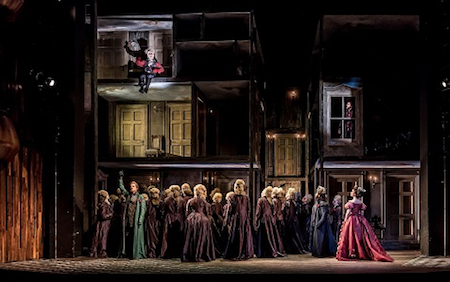
06 Nov 2016
Wexford Festival Opera 2016
This year’s Wexford Festival was all about the women. Deluded, dangerous, depressed, deranged, they stood centre-stage and commanded the emotional territory.
English Touring Opera are delighted to announce a season of lyric monodramas to tour nationally from October to December. The season features music for solo singer and piano by Argento, Britten, Tippett and Shostakovich with a bold and inventive approach to making opera during social distancing.
This tenth of ten Live from London concerts was in fact a recorded live performance from California. It was no less enjoyable for that, and it was also uplifting to learn that this wasn’t in fact the ‘last’ LfL event that we will be able to enjoy, courtesy of VOCES8 and their fellow vocal ensembles (more below …).
Ever since Wigmore Hall announced their superb series of autumn concerts, all streamed live and available free of charge, I’d been looking forward to this song recital by Ian Bostridge and Imogen Cooper.
The Sixteen continues its exploration of Henry Purcell’s Welcome Songs for Charles II. As with Robert King’s pioneering Purcell series begun over thirty years ago for Hyperion, Harry Christophers is recording two Welcome Songs per disc.
Although Stile Antico’s programme article for their Live from London recital introduced their selection from the many treasures of the English Renaissance in the context of the theological debates and upheavals of the Tudor and Elizabethan years, their performance was more evocative of private chamber music than of public liturgy.
In February this year, Albanian soprano Ermonela Jaho made a highly lauded debut recital at Wigmore Hall - a concert which both celebrated Opera Rara’s 50th anniversary and honoured the career of the Italian soprano Rosina Storchio (1872-1945), the star of verismo who created the title roles in Leoncavallo’s La bohème and Zazà, Mascagni’s Lodoletta and Puccini’s Madama Butterfly.
Evidently, face masks don’t stifle appreciative “Bravo!”s. And, reducing audience numbers doesn’t lower the volume of such acclamations. For, the audience at Wigmore Hall gave soprano Elizabeth Llewellyn and pianist Simon Lepper a greatly deserved warm reception and hearty response following this lunchtime recital of late-Romantic song.
Collapsology. Or, perhaps we should use the French word ‘Collapsologie’ because this is a transdisciplinary idea pretty much advocated by a series of French theorists - and apparently, mostly French theorists. It in essence focuses on the imminent collapse of modern society and all its layers - a series of escalating crises on a global scale: environmental, economic, geopolitical, governmental; the list is extensive.
For this week’s Live from London vocal recital we moved from the home of VOCES8, St Anne and St Agnes in the City of London, to Kings Place, where The Sixteen - who have been associate artists at the venue for some time - presented a programme of music and words bound together by the theme of ‘reflection’.
'Such is your divine Disposation that both you excellently understand, and royally entertaine the Exercise of Musicke.’
Amongst an avalanche of new Mahler recordings appearing at the moment (Das Lied von der Erde seems to be the most favoured, with three) this 1991 Mahler Second from the 2nd Kassel MahlerFest is one of the more interesting releases.
‘And there was war in heaven: Michael and his angels fought against the dragon; and the dragon fought and his angels, And prevailed not; neither was their place found any more in heaven … that old serpent … Satan, which deceiveth the whole world: he was cast out into the earth, and his angels were cast out with him.’
If there is one myth, it seems believed by some people today, that probably needs shattering it is that post-war recordings or performances of Wagner operas were always of exceptional quality. This 1949 Hamburg Tristan und Isolde is one of those recordings - though quite who is to blame for its many problems takes quite some unearthing.
There was never any doubt that the fifth of the twelve Met Stars Live in Concert broadcasts was going to be a palpably intense and vivid event, as well as a musically stunning and theatrically enervating experience.
‘Love’ was the theme for this Live from London performance by Apollo5. Given the complexity and diversity of that human emotion, and Apollo5’s reputation for versatility and diverse repertoire, ranging from Renaissance choral music to jazz, from contemporary classical works to popular song, it was no surprise that their programme spanned 500 years and several musical styles.
The Academy of St Martin in the Fields have titled their autumn series of eight concerts - which are taking place at 5pm and 7.30pm on two Saturdays each month at their home venue in Trafalgar Square, and being filmed for streaming the following Thursday - ‘re:connect’.
The London Symphony Orchestra opened their Autumn 2020 season with a homage to Oliver Knussen, who died at the age of 66 in July 2018. The programme traced a national musical lineage through the twentieth century, from Britten to Knussen, on to Mark-Anthony Turnage, and entwining the LSO and Rattle too.
With the Live from London digital vocal festival entering the second half of the series, the festival’s host, VOCES8, returned to their home at St Annes and St Agnes in the City of London to present a sequence of ‘Choral Dances’ - vocal music inspired by dance, embracing diverse genres from the Renaissance madrigal to swing jazz.
Just a few unison string wriggles from the opening of Mozart’s overture to Le nozze di Figaro are enough to make any opera-lover perch on the edge of their seat, in excited anticipation of the drama in music to come, so there could be no other curtain-raiser for this Gala Concert at the Royal Opera House, the latest instalment from ‘their House’ to ‘our houses’.
"Before the ending of the day, creator of all things, we pray that, with your accustomed mercy, you may watch over us."

This year’s Wexford Festival was all about the women. Deluded, dangerous, depressed, deranged, they stood centre-stage and commanded the emotional territory.
Félicien David’s Herculanum (1859) builds a melodrama from pathetic fallacy. Set in AD 79, during the reign of Emperor Titus, one year after the conquest of Jerusalem, this tale of the Roman Queen Olympia’s attempt to seduce the Christian slave Helios takes place in the shadow of Vesuvius, and the mountain’s impending eruption both signals and seals the fate of the reprehensible monarch and her citizens and slaves. Director Stephen Medcalf and his designer Jamie Vartan (re-united following their acclaimed Wexford productions of Delius’s A Village Romeo and Juliet in 2012 and Foroni’s Cristina, regina di Svezia in 2013) mark this visually. The initial front-drop presents us with a brooding volcano, which by the start of Act 2 has begun to belch smoke; by the final act, the magma is boiling and bubbling.
But, other than a concluding video animation of an eruption which smothers all bar the central pair of protagonists in molten lava before a dramatic draining of colour entombs the citizens of Pompei in ash, Medcalf struggles to bring some fire to David’s only grand opera. This is not surprising for, despite the richness of the melodic writing and some interesting orchestral effects, the opera is not wholly successful in bringing the hefty conflicts between political and religious groups, and the excessive emotions which the audience of the Paris Opera demanded and expected, into a convincing and dynamic dramatic form.
The central conflict is between a chaste Christian couple, Lilia and Hélios, and a despicable brother-sister-brother despotic duo, Olympia and Nicanor, who hail from Euphrates but have been elevated by the Romans to be Queen and Proconsul respectively. Olympia - named for her devotion to Mount Olympus - must halt the advance of Christianity either by executing the Christians martyrs or by converting them to paganism through seduction. She desires the slave Hélios, and wins him by means of a potion, her alluring beauty and the magnificence of her court. Nicanor lusts after Lilia, but even though he shows her a vision of Hélios’s betrayal, she remains steadfast in her loyalty to Hélios and to her God. Infuriated by his failure, Nicanor declares that her God does not exist. A bolt of lightning immediately strikes him down, whereupon Satan appears and dons the corpse’s cloak. When confronted by his Christian beloved, Helios wavers but, believing that his act will save Lilia’s life in the face of the Queen’s jealous fury, he reasserts his devotion to Olympia. Meanwhile Satan invokes an uprising among the Christian slaves, but as Lilia and Hélios are reconciled, the Devil causes Vesuvius to erupt and the beloveds rise, in redemption, to heaven.
Medcalf and Vartan adopt a stylised approach. Before a backdrop of the foot of Vesuvius, on a steeply raked stage, the chorus of pagans gather to worship Olympia, striking poses in the manner of a Greek chorus. Lighting designer Christopher Akerlind illuminates them in intermittent squares of light, anticipating the transfiguring frame of light that will fall upon Hélios and Lilia in the opera’s closing frame.
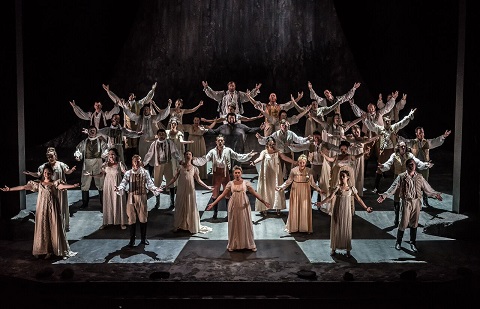 Chorus of Wexford Festival Opera. Photo credit: Clive Barda.
Chorus of Wexford Festival Opera. Photo credit: Clive Barda.
The stylish French-Empire costumes reference the period of the opera’s composition, and it is worth remembering that ‘Olympe’ was a noms-de-guerre frequently assumed by upper-class prostitutes in France at this time. The name was used by writers such as Alexandre Dumas (in his 1851 novel, Olympe de Clèves) and Émile Augier (in his 1855 play Le Mariage d’Olympe), while Édouard Manet’s ‘Olympia’ shocked viewers at the 1865 Paris exhibition as details identified the naked woman, who stares confrontationally at the viewer, as a prostitute.
Daniela Pini’s regal Olympia entered from a hollow at the base of the mountain and the Italian mezzo-soprano made the cruel Queen’s power and potency forcefully evident. Forced to kiss her sceptre, four ‘oriental’ captives are pushed to the floor by Nicanor’s sword, their backs forming a bridge for Olympia to walk across - just because she can. Pini’s voice is rich and full, though the middle range is lighter. She sang with agility and reasonable accuracy, after some initially wayward tuning. She has a striking and appealing stage presence - as was also evident during a lunchtime recital later in the week, when she showed her stylistic range in numbers by Tosti, Rossini, Canteloube, even throwing in Harold Arlen’s ‘Somewhere Over the Rainbow’. Olympia’s drinking song - a boisterous polonaise - was the centrepiece of the first act. She declares her intention to make herself Hélios’s god, and the swiftness of the Christian’s submission suggests either the toxicity of potion with which she tempts and drugs him, or the fragility of his own faith. A cross between Cleopatra and Salome, Pini’s Olympia was strong and defiant to the close; her wild, uncontrollable laughter, echoed by the chorus, rang out at the final curtain.
As Olympia’s servile adulators, the Wexford Festival Chorus were in fine voice. The set design did not allow room for much bacchanalian debauchery though, particularly when tables laden with wine and victuals descended from the flies taking up floor space. Medcalf had to rely on symbolic poses - a kiss between two female revellers, some fawning threesomes in Act 3, Olympia and Nicanor frozen in an embrace, hinting at incest - to evoke the dissipation of the pagan court. Given the space constraints, we could have done without the Act 3 divertissement, which struggled to create dramatic interest despite the colourful orchestral detail. In Act 2, scattered bare rocks and a backcloth depicting interlocked, tottering crosses conveyed the Christians’ suffering, and the chorus - now dressed in drab prisoners’ rags - delivered a touching hymn.
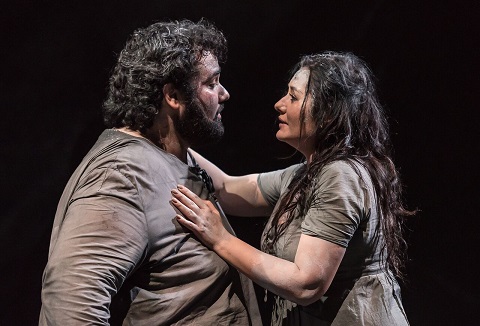 > Andrew Haji & Olga Busuioc. Photo credit: Clive Barda.
> Andrew Haji & Olga Busuioc. Photo credit: Clive Barda.
Canadian tenor Andrew Haji gave a strong performance as Hélios. Having drained the Queen’s proffered goblet, the weak-willed slave delivered an ecstatic declaration of love for Olympia which was impassioned, sweet-toned and gracefully phrased. Haji has a lovely lyric tenor which stays firm and sure even when expressing extremes of joy or repentance. His romance with Olga Busuioc’s Lilia in the opening act, heightened by the oboe’s gentle sighs, presented a moving portrait of their pure love, simple life and true faith.
Romanian Busuioc displayed considerable strength and colour as Lilia, but did not match Pini’s vocal control; the line was not always even and elegant. Her Act 3 Credo was committed and intense, however, as she persisted to profess her faith in the face of the pagans’ cries for her execution. And, Busuioc’s lengthy duet with Haji in Act 4 was a high-point, musically and vocally.
As Nicanor, English bass-baritone Simon Bailey lacked a little darkness at the bottom but sang fluently and acted well. His Act 2 duet with Lilia was secure and the tone appealing. When ‘resurrected’ as Satan, Bailey had an unfortunate ‘Ready Brek glow’ (for those who remember TV advertisements of the 1980s), inadvertently lessening his menace; but, Satan’s imploring cries to the Christians to rise up and rebel, at the start of the final act, were urgent, rousing and spine-chilling. It was a terrific moment of theatre … as if we had strayed into the barricades scene in Claude-Michel Schönberg’s Les Misérables. Irish baritone Rory Musgrave, as the divinely inspired prophet Magnus, matched Bailey’s intensity. Musgrave’s monotone declamation in the opening act was focused and captivating, and the image of the prophet stripped to a ragged loincloth, smeared with blood and wine, was as arresting as the tremor of Vesuvius that thundered at this point.
Conductor Jean-Luc Tingaud drew forth the details from David’s colourful score; the orchestral interlude portraying the effect of the love potion on Hélios was vibrant and evocative, and Tingaud appreciated the way in which David’s orchestration - much admired by Berlioz - enhances moments of tension and majesty.
In its day, Heraculanum was as popular at the Paris Opera as Gounod’s Faust and Verdi’s V êpres Siciliennes: in 1867 the Emperor Napoleon III awarded the opera a prize, as the ‘work most appropriate to honour the country’. But, though this was a worthy production, Medcalf struggled to overcome the frequent flatness of David’s score which is only sporadically animated by a stirring chorus or theatrical éclat.
David Agler’s first Festival programme, in 2005, included Carlisle Floyd’s Susannah (1955). Since then, the US-born, Canadian-domiciled Agler has introduced a series of American operas to Wexford audiences: Conrad Susa’s 1973 two-act chamber opera Transformations in 2006;The Ghosts of Versailles (1991) by John Corigliano in 2009; The Golden Ticket by Peter Ash, an opera based on Roald Dahl’s Charlie and the Chocolate Factory in the year of its premiere, 2010; and Kevin Puts’ Silent Night (2011) in 2014.
This year, Agler invited Rodula Gaitanou - whose 2012 WFO production of Delius’s A Village Romeo and Juliet was deservedly admired - to direct Samuel Barber’s Vanessa. When it was premiered at the Met in 1958, Barber’s first opera was hailed as ‘the best U.S. opera yet staged at the Metropolitan’ by the New York Herald Tribune, ‘the finest and most truly ‘operatic’ opera ever written by an American’ in the New Yorker, and won Barber the 1958 Pulitzer Prize. Yet, European stagings are not common. Gaitanou’s thoughtful, probing production showed why they should be. With designer Cordelia Chisholm, Gaitanou balanced the Chekhovian introspection and pathos of the opera with its great Romantic theatricality, and in so doing conjured a penetrating, modern, psychological intensity.
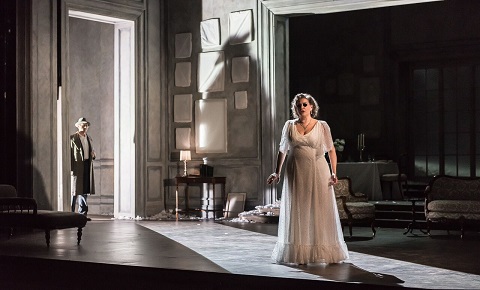 Michael Brandenburg and Claire Rutter. Photo credit: Clive Barda.
Michael Brandenburg and Claire Rutter. Photo credit: Clive Barda.
The libretto was written by Barber’s life-long partner, Gian Carlo Menotti. The action is set in 1905 - Gaitanou’s updating to the 1950s is inconspicuous and unobjectionable - in an unspecified ‘northern country’. Vanessa, a ‘lady of great beauty’ and Erika, Vanessa’s passionate but naive twenty-year-old niece, live in Vanessa’s country house with the latter’s mother, the Old Baroness, who refuses to speak to Vanessa. For twenty years, Vanessa has shut herself away, yearning for Anatol, her long-lost lover. At the start of the opera, she excitedly but anxiously anticipates his return, but the man who arrives is in fact Anatol’s son. He shares his late father’s name, and charisma: Vanessa accepts the younger man as a substitute for her former love; Erika too succumbs to his charms. Anatol toys with the affections of both women, though it Erika to whom he proposes, only to have his marriage offer rejected, for she senses that he does not love her. Vanessa and Anatol subsequently announce their engagement, at a ball. Erika, pregnant with Anatol’s child, rushes out into the cold night; she is later discovered, half-frozen. She has aborted her pregnancy, and the Baroness punishes her with silence. Vanessa and Anatol prepare to move to Paris leaving Erika to take her aunt’s place, entombed within the house, enduring the Baroness’s silence, and aching for lost love.
Menotti described the opera as a story of ‘two women ... caught in the central dilemma which faces every human being, whether to fight for one’s ideals to the point of shutting oneself off from reality, or to compromise with what life has to offer, even lying to oneself for the mere sake of living’.
Chisholm’s quiet, grey set, with French windows set at different depths through which we glimpse the gently falling snow, conjures a frozen world. Time has stopped for Vanessa; the mirrors and paintings are covered to negate the reality that the glass would assert. Vanessa hides in the past, but in so doing paradoxically smothers the vitality of her youth: we are reminded of Blanche DuBois’s fear of the light that would illuminate the truth, and of T.S. Eliot’s observation, ‘Human kind cannot bear very much reality.’ The Baroness stands at an easel, painting the truthful likenesses that Vanessa seeks to deny.
Claire Rutter immediately communicated Vanessa’s impetuousness and fragility. Excitedly instructing her old retainers to prepare food and wine for the anticipated visitor, Rutter’s gorgeously vivid soprano evoked the force of Vanessa’s wilfulness and self-centredness. She tackled the role’s coloratura demands with flamboyance and flair, and the ornamentation and chromaticism that convey Vanessa’s erraticism was totally secure. Snatching the copy of Oedipus from which Erika is reading to her, Vanessa criticises her niece's lack of passionate intensity - ‘You do not know how to read. You have never known what love is.’ Rutter then launched into Vanessa’s own melodramatic recitation with theatrical and musical abandon, relishing the elongations and plunges of Barber’s melodic oration, easily negotiating its floridity and wide range.
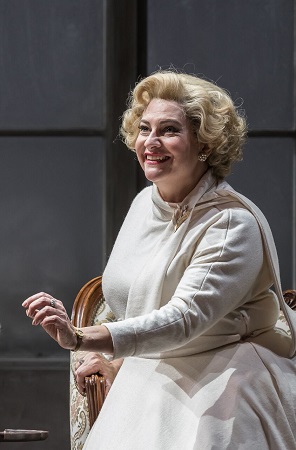 Claire Rutter as Vanessa. Photo credit: Clive Barda.
Claire Rutter as Vanessa. Photo credit: Clive Barda.
But, Rutter did not neglect to reveal the precariousness of Vanessa’s psychological state. Anatol’s arrival was signalled visually by a looming, menacing shadow, as Vanessa turned her back to her imagined former lover, instructing him, ‘Do not utter a word’; the long aria which followed was dramatic and tense, building mesmerizingly to Vanessa’s shriek of horror when the young man responds, ‘I think I could love you’, and reveals her delusion and error.
Carolyn Sproule’s Erika was, by contrast, pragmatic and more self-contained; though Erika’s delicate poetic sensibility and naivety were apparent from the first. Sproule’s lovely mezzo-soprano glided through Erika’s lyrical melodic phrases, but there was a dark gleam to the tone that hinted at inner spiritedness and soul, and that came gradually and painfully to the surface.
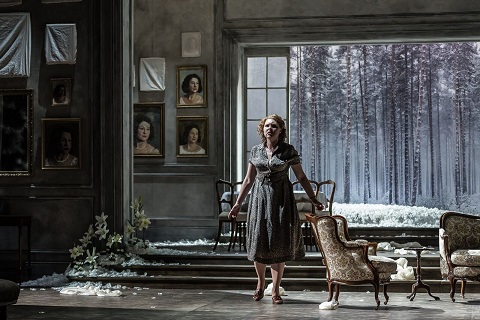 Carolyn Sproule as Erika. Photo credit: Clive Barda.
Carolyn Sproule as Erika. Photo credit: Clive Barda.
Michael Brandenburg’s Anatol was a magnetic and reckless imposter, ostentatiously teasing Erika by referring to Boris Godunov, describing himself as ‘the false Dmitri, the Pretender’ and inviting Erika to become his ‘Marina’. Brandenburg coped bravely with the high tessitura and had the vocal resilience to negotiate the stamina-demanding passages, such as his big Act 2 duet with Vanessa.
Rosalind Plowright was a disquieting presence as the Old Baroness: knowing, candid and unforgiving, she was a steely portrait of disapproving hauteur. As the Old Doctor, James Westman, singing with a warm, full baritone, brought some welcome lightness and wit: nimbly teaching Anatol to dance, drunkenly and insouciantly tossing champagne flutes to the footman. The Wexford Festival Orchestra played with fire and vigour under conductor Timothy Myers.
Gaitanou and Chisholm effectively conveyed the psychological reversal that we witness unfold. We watched the frivolities and fun of the ballroom scene through Erika’s eyes: standing alone on the staircase, she caught fleeting glimpses of whirling coloured dresses through the frosted glass, and felt the warmth of the celebration through an intermittently opened door. As the now blonde Vanessa sought to re-live the past, so Erika’s youthfulness drained away. The dissonant, homophonic lament in Act 4, as the principals stepped out of character to form a Greek-style chorus, evoked pity not just for the senselessness of Erika's wasted youth but also for the ephemerality of all beauty and life.
Last year, director Fabio Ceresa’s thrilling staging of Pietro Mascagni’s Guglielmo Ratcliff placed infatuation, passion and bloody violence centre-stage and conjured quintessential Gothic terror. This year, Ceresa reunited with costume designer Giuseppe Palella and Riccardo Olivier, who choreographed Guglielmo Ratcliff and now served as Ceresa’s assistant director, to dish up more supernatural vengeance, excessive bloodshed and stirring shudders of foreboding in the form of Donizetti’s overwrought tale of sexual obsession - his 1838 dramma tragico, Maria de Rudenz.
Maria de Rudenz stems from a troubled time in Donizetti's life. His wife, Virginia, had died in July 1837 during a cholera epidemic, at the age of only twenty-eight. The composer had also recently lost his parents, and three infant children. Grief-stricken, he had to fulfil his commitments to complete Roberto Devereux, negotiate with the Paris Opera with respect to censorship arrangements, and honour a contract with impresario Alessandro Larani to composer an opera for the re-opening, after a fire, of La Fenice.
Based on an 1835 play by Auguste Anicet-Bourgoeis and Julien de Mallian, La Nonne sanglante (which was itself sourced from an episode in Matthew Lewis’s 1796 novel, The Monk), Salvadore Cammarano’s libretto for Maria de Rudenz is one of the most gothic texts that Donizetti ever set. It practically haemorrhages uncanny, unsettling effects and symbols - bloody daggers and damaged psyches, sepulchres and spectral visitations, echoing crypts and secret chambers. When it was ruled too bloody, because no one was left standing at the final curtain, Cammarano omitted one of the corpses and the text slipped through the censors’ net.
Before the opera begins, Maria de Rudenz has been abandoned in the catacombs by her dastardly seducer Corrado, with whom she has eloped in defiance of her father. She escapes with the aid of a guide and returns to Rudenz to find that Corrado now plans to marry her cousin, Matilde - who, in the apparent absence of any other heir, will inherit the property. Torn between murderous rage and rampant passion, she tries to win him back - though it is perhaps not surprising that her extreme ploys fail: she threatens to cast Matilde into an abyss under the floor. Stabbed by Corrado, she does not die but creeps offstage into the bridal chamber to murder her rival. Corrado is confronted by what he assumes is Maria’s ghost. Maria, ‘resurrected’ from the grave, declares that she loves Corrado in spite of all that has happened - but then, in remorse, she rips bandages from her arms and dies in Corrado’s arms.
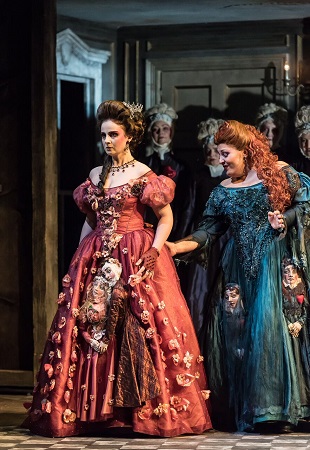 Sophie Gordeladze (Matilde) & Gilda Fiume (Maria de Rudenz). Photo credit: Clive Barda.
Sophie Gordeladze (Matilde) & Gilda Fiume (Maria de Rudenz). Photo credit: Clive Barda.
So, in good gothic fashion, the past invades and deranges the present. The original libretto is set in 15th-century Switzerland, but Ceresa and his set designer, Gary McCann, update the action to the period of the opera’s composition. They have constructed a monumental, multi-level set - an outsize, horror-film doll’s house - presenting us with a plethora of rooms lit in lurid greens, blues and crimsons by Christopher Akerlind. Much fussy activity ensues with the shadowy shoeboxes; and, pity the technical crew who have to manoeuvre this bulky construction with pinpoint precision, opening up fissures, exposing corners, and creating anxiety-inducing niches and angles.
Palella’s opulent, outré costumes for Guglielmo Ratcliff were a major contribution to that production’s disturbing, dislocating detachment, evoking a surreal inaccessible world which was nevertheless imaginatively gripping. Here, the outré verged on outlandish; the chorus, in particular, kitted out in purple and black cloaks adorned with scarlet, pierced pin-cushion hearts and sporting other-worldly head-dresses, looked as if they’d strayed in from the set of Kubrick’s Eyes Wide Shut.
As with Guglielmo Ratcliff, Ceresa successfully overcame the static nature of the expository accounts that are required to fill us in on the characters’ violent back-stories, and he whipped us skilfully through the recitative between the first two set pieces. However, after such swiftness, things become unnecessarily fussy. Puppets, manipulated with viciousness and vindictiveness by the protagonists, are perhaps intended to evoke the otherworldliness - the liminality - of Maria herself, hovering between life and death. But, there was so much tongue-in-cheek irony that the Gothic terror wilted: when Matilde slapped the Maria marionette the audience chortled; similarly, the beheading of the puppet which represented Corrado’s father generated much merriment. Gallows humour drifted into spoof.
Fortunately, the musical merits were considerable. In the title role - as the ‘woman who will not die’ - Gilda Fiume blazed her way through the technical demands, surmounting the stratosphere, nimbly whisking through the coloratura, and proved herself very much the soprano drammatico d’agilita. Her entrance aria won a sympathy that endured, despite her subsequent psychosis, as she wept in despair and announced her intention to retire to a convent and expiate the sin of defying her father’s wishes. Maria’s impassioned outpouring of love for Corrado, at the end of Act 2, burned with frenzied passion but was sweet of tone. The declamation at the end of this Act was powerfully focused. And, Fiume’s final aria displayed astonishing theatricality as she first revealed her vengeful anger in a slow movement of surprising melodic vigour, vocal control and stamina, with urgent leaps and tight rhythms; then, in the cabaletta, she won our sympathy - for it is love that drove her to such terrible crimes - with some astonishing pianissimo singing.
The Korean baritone Joo Won Kang gave an equally exciting performance as Corrado: he coped with the Verdian tessitura, his tone was silky, the phrasing elegant - he almost made a hero of the villain! Corrado’s sortita, ‘Ah! non avea piu lagrime’ is a renowned baritone warhorse but it was despatched with ease and aplomb; the embellishments were stylish.
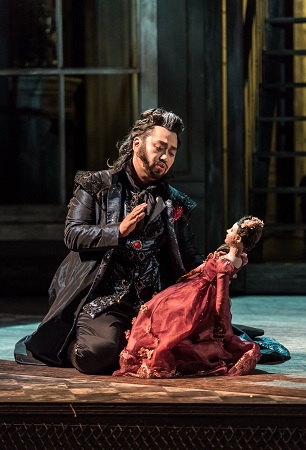 Joo Won Kang as Corrado. Photo credit: Clive Barda.
Joo Won Kang as Corrado. Photo credit: Clive Barda.
American tenor Jesus Garcia did his best to make something of the tangential role of Enrico. Similarly, Michele Patti made an effective contribution as Rambaldo, the old retainer, even though he had only a few recitative passages and interjections in choruses to make his mark. Georgian soprano Sophie Gordeladze displayed a piercing precision at the top as Matilde, though she was occasionally a bit shrill.
Chorus Master Errol Girdlestone had done sterling with the Wexford Festival Chorus, as was especially noticeable at the start of Act 3 when a spectre has been seen wandering the halls near the bridal chamber. Even though Donizetti’s music is surprisingly ‘jolly’ at this point - operatic convention demands an upbeat chorus - one could still admire the strength and vigour of the singing.
Conductor Andrew Greenwood made sure that we appreciated Donizetti’s vivid orchestration: the flutes sobbed painfully in Maria’s opening aria; eerie sound effects - string tremolos, keening woodwind, tolling timpani, powerful dark horn colourings - evoked a disturbed world.
The opening run of Maria de Rudenz at the Fenice consisted of just two performances; then, after a few performances in Italian cities, the opera fell into oblivion. Wexford made a good case for its musical merits though Cesera over-indulged his gothic imagination and presented us with Chinese boxes that the ghoulish tale does not require.
Other than Cesera’s dark witticisms, there weren’t many laughs in the main house this year. But, director Roberto Recchia can always be relied on to provide some rib-tickling comedy. Returning to the early-nineteenth century Italian repertoire (see my reviews of L’elisir d’amore (2013) and La Cenerentola (2014)), he offered us yet another delightful Short Work - Donizetti’s melodramma giocoso, II Campanello.
Il Campanello (The bell) - number fifty-three on William Ashbrook’s list of the seventy Donizetti operas - is a one-act, one-hour farce for which the composer himself wrote the libretto, basing it upon on a French vaudeville, La sonnette de nuit.
The elderly Neapolitan apothecary Don Annibale Pistacchio has just married the lovely Serafina, to the chagrin of her rejected suitor, Enrico. Out of spite, Enrico disrupts the wedding supper with delaying tactics - including a lengthy and ridiculous anecdote about Zasse, Zansze, and Zonzo, and a protracted drinking song. When the nuptial pair have departed for an evening of bliss, he creeps back to re-arrange the furniture, intending to trip up the lustful Don Annibale as he rushes eagerly to Serafina’s bedroom. During the night, Enrico interrupts the newly-weds by noisily ringing the bell, returning three times: first, in the guise of a pretentious French fop, then disguised as a hoarse opera singer, and finally as an old man who has every ailment that can be catalogued in a patter song par excellence. The law states that any apothecary who does not answer the night bell and provide his patients with the necessary prescription, whatever the hour, is liable to imprisonment, so the frustrated Don Annibale is obliged to tend to his visitors needs rather than his own erotic desires. As dawn approaches, the bell rings once again, and it is announced that the despairing, utterly confused pharmacist has been summoned to Rome on legal business, leaving the coast clear for Enrico to pursue Serafina.
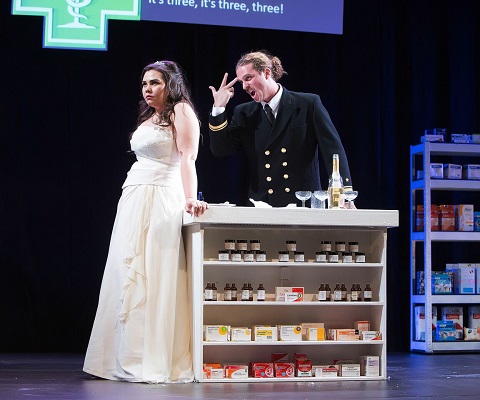 Rachel Croash (Serafina) & Michele Patti (Enrico). Photo credit: Malone Carty.
Rachel Croash (Serafina) & Michele Patti (Enrico). Photo credit: Malone Carty.
Donizetti links seven musical numbers with secco recitative, and provides copious opportunities for theatrical hyperbole and absurdity. Though it was a bit slow to get going, Recchia’s production was soon bubbling along at full throttle. The director knows how to make much from small means; economic constraints are no hindrance to a fertile imagination. So, though the raised platform in White’s Hotel - where the Short Works were again staged this year - was sparsely decorated, the clinical monochrome décor, illuminated Bowl of Hygieia insignia and medicinal cabinet succinctly set the scene, and told us all we needed to know about the likelihood of the frolicsome Serafina finding happiness with the unsentimental Don Annibale.
Donizetti enlivens the wedding feast by sprinkling the score with a Rossinian parody and some self-quotation. Taking the bait, after a prolonged and unruly brindisi, Recchia allowed the guests to indulge in a karaoke spectacle: the chorus shone in a barbershop quartet of Cole Porter’s ‘It’s De-Lovely’ accompanied by air-bass, while music director Tina Chang - fortified by a swig of wine from the bottle under her piano and a Gloria Gaynor-wig - launched into a fervent rendition of ‘I Will Survive’.
The two baritones in the cast have to do most of the work. In this performance, both proved excellent actor-singers and provided much enjoyment. Don Annibale’s opening aria, in which he anticipates his future offspring, was well sung by Pietro di Bianco, who settled into the role quickly and negotiated the high-lying line with ease.
Michele Patti relished Enrico’s bluster and audacity. In his mock-dramatic confrontation with Serafina, his threat to commit suicide prompted nothing more than a soaking with water from the indifferent bride, but his ingenuity was not dampened and he impersonated the ailing nighttime interlopers with aplomb. The opera singer’s number offered Patti the opportunity to show how good he is at singing both well and badly! Aided by a wincing Chang, he sought and failed to find his notes, but leapt up and down the octaves impressively, polishing off his performance (of ‘Nessun Dorma’) with a vocal flourish accompanied by a quaff of wine. As the indisposed pensioner, Patti whisked through his lexical extravaganza - an inventory of pharmaceutical requirements to outshine even Dulcamara’s virtuosic litany of cure-all remedies. His treatise listed every tonic imaginable, from the navel of Venus to asparagus, from grease to dry rot, an overload of tonics that caused the surtitles to fizz and malfunction.
Rachel Croash was bright of voice and vivacious of presence as Serafina, and she negotiated the coloratura confidently. As Serafina’s rapacious and shamelessly lascivious mother, Madame Rosa, Michaela Parry was a scream, swooning histrionically, flirting shamelessly, and gorging and imbibing unrestrainedly until she was sick in her wedding hat! Aidan Coburn was terrific as the resourceful Spiridione, Don Annibale’s lab assistant. A charming farewell trio rounded things off, but Serafina’s promises to stay faithful were wryly undermined by the final image of the entire cast pairing off for a lusty embrace.
Vaughan Williams’ poetic hymn to pain and resignation, Riders to the Sea, was an altogether more sombre and sobering affair. This time the bare stage was adorned with fishing nets, baskets, driftwood, a wooden table, a turf oven - the quiet but intense meagreness of life of the Aran Islands’ fisher-folk.
The composer’s almost verbatim setting of J.M. Synge’s play is a harrowing threnody in which a family living on the Isles, off the coast of Galway, come to terms with losing a grandfather, father, husband and five sons to the deep Irish waters. The opera is a compendium of resigned suffering worthy of a Greek tragedy, and this was effectively signalled by the slowing pouring of water from a jug and the monotonous kneading of dough that preceded the first bars of music. We were made to wait, as the family perpetually wait when the menfolk are at sea.
Director Caitriona McLaughlin and her set and lighting designers, Robbie Sinnott and Rory Beaton, allowed the tragedy to unfold with haunting simplicity. Philippa Boyle’s Cathleen was silvery and piercing, but not strident, pressing home the intensity of fear and loss, while Katie Lowe’s Nora was warmer and more richly coloured, revealing the depth and range of painful emotions. As Maurya’s last living son, Bartley, Lukasz Karauda’s robust baritone declaimed powerfully, suggesting masculine strength and optimism, and a doomed innocence.
The casting of Lara Rebekah Harvey as Maurya, however, was a mistake, not because of any technical deficiencies, but because Harvey simply looked too young and slight to have borne such suffering. More Dickensian urchin than bereaved daughter, wife and mother, Harvey was given a cartoonish white wig that only added to the incongruity. A walking stick might have helped, as it would have forced Harvey to adopt an altogether different physical demeanour. But, in the absence of any such enabling props, she sang reliably but introspectively - though there was a more ecstatic energy driving Maurya’s dream sequence.
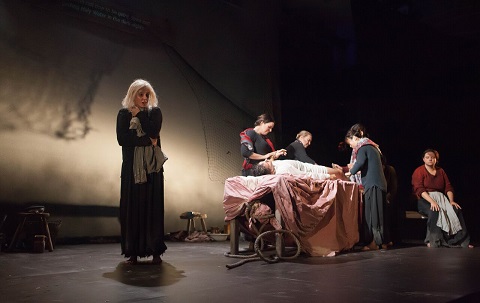 Lara Harvey & the cast of Riders to the Sea. Photo credit: Malone Carty.
Lara Harvey & the cast of Riders to the Sea. Photo credit: Malone Carty.
The choral keening, the glow of candlelight, the washing and shrouding of Bartley’s corpse all powerfully conveyed the family’s unremitting anguish. And, the piano accompaniment highlighted the organum-like harmonies and textures of the score, capturing the spiritual stillness of this disquieting opera.
Sadly, I was not able to see the third of Wexford’s Short Works, William Walton’s The Bear - another rarely performed opera, and thus typical Wexford fare. But, artistic director David Agler’s 12th festival offered much else to enjoy, and not just in the main house. Agler continues to innovate and develop: this year the lunchtime song recitals opened with a performance by the RTÉ Contempo Quartet, who offered the audience gathered in St. Iberius Church a diverse, challenging programme of quartets by Haydn and Bartók, framing a new work, 2016.3, by young Irish composer, Sebastian Adams.
Next year, the plan is to return to an 18-day Festival, which will extend over three weekends, and the programme is characteristically eclectic and adventurous. After the success of Cristina, regina di Svezia - for which Wexford won the Best Re-discovered Work Award at the International Opera Awards in 2014 - the Festival will return to Foroni, presenting the composer’s melodramma semiserio, Margherita, which was first heard in Milan in 1848, one year before Cristina was premiered in Stockholm. Risurrezione (1904) by Franco Alfano, best known for having completed the score of Puccini’s Turandot, and Cherubino’s Medea - which will star the 2015 Operalia winner Lise Davidsen - make up the trio of operas.
The 66th Wexford Opera Festival runs from Thursday 19th October to Sunday 5th November 2017.
Claire Seymour
Herculanum:
Lilia - Olga Busuioc, Olympia - Daniela Pini, Hélios - Andrew Haji, Nicanor/Satan - Simon Bailey, Magnus - Rory Musgrave; Director - Stephen Medcalf, Conductor - Jean-Luc Tingaud, Set & Costume Designer - Jamie Vartan, Lighting Designer - Christopher Akerlind, Chorus Master - Errol Girdlestone, Orchestra and Chorus of Wexford Festival Opera.
Vanessa :
Vanessa - Claire Rutter, Erika - Carolyn Sproule, The Old Baroness - Rosalind Plowright, Anatol - Michael Brandenburg, The Old Doctor - James Westman, Nicholas - Pietro di Bianco; Director - Rodula Gaitanou, Conductor - Timothy Myers, Set & Costume Designer - Cordelia Chisholm, Lighting Designer - Christopher Akerlind, Chorus Master - Errol Girdlestone
Maria De Rudenz:
Maria de Rudenz - Gilda Fiume, Matilde di Wolf - Sophie Gordeladze, Corrado Waldorf - Joo Wan Kang, Enrico - Jesus Garcia, Rambaldo - Michele Patti, Chancellor of Rudenz - Richard Shaffrey; Director - Fabio Ceresa, Conductor - Andrew Greenwood, Set Designer - Gary McCann, Costume Designer - Giuseppe Palella, Lighting Designer - Christopher Akerlind, Chorus Master - Errol Girdlestone, Orchestra and Chorus of Wexford Festival Opera.
Il Campanello:
Serafina - Rachel Croash, Don Annibale- Pietro di Bianco, Spiridione - Aidan Coburn, Madama Rosa -Michaela Parry, Enrico - Michele Patti, Coro (soprano) - Maria Hughes, Coro (mezzo-soprano) -Heather Ireson, Coro (tenor) - Andrew Gavin, Coro (bass) - Henry Grant Kerswell; Director - Roberto Recchia, Music Director - Tina Chang, Stage & Costume Designer - Robbie Sinnott, Lighting Designer - Rory Beaton.
Riders to the Sea:
Maurya - Lara Rebekah Harvey, Cathleen - Philippa Boyle, Nora - Katie Lowe, Bartley - Lukasz Karauda, The Woman/Coro (mezzo-soprano) - Lucilla Graham, Coro (soprano) - Eleanor Garside, Coro (soprano) - Jessie Tse, Coro (mezzo-soprano) - Sophie Goldrick; Director - Caitriona McLaughlin, Music Director - Benjamin Laurent, Stage & Costume Designer - Robbie Sinnott, Lighting Designer - Rory Beaton.
Wexford Festival Opera, Ireland; 26th-28th October 2016.